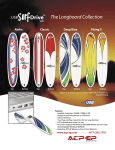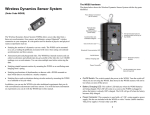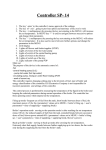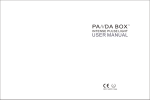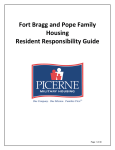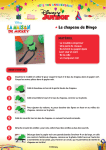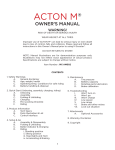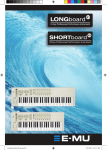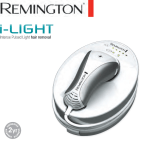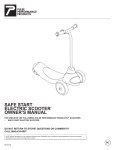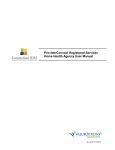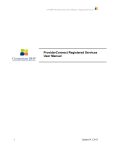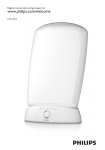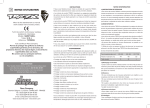Download longboard user manual
Transcript
PLEASE READ THE USER MANUAL CAREFULLY BEFORE FIRST USE OF THE LONGBOARD USING THE LONGBOARD IN A MANNER INCONSISTENT WITH THE USER MANUAL IS AT THE SOLE RISK AND RESPONSIBILITY OF THE USER DEFINITIONS The Importer and the Distributor are also deemed to be the Manufacturer. The User is deemed to be any person who uses the LONGBOARD. The person who was issued this user manual is required to provide it to any person who intends to use the LONGBOARD, prior to its use. GENERAL WARNING: THE LONGBOARD IS NOT A TOY. Riding on the LONGBOARD is a popular form of recreation, although it may also be used for competitive or sports purposes. However, as with most sports, there are some risks and dangers associated with riding on the LONGBOARD, including with assistance in riding and its observation. The principles of riding on the LONGBOARD, in particular the principle of moving in public places, including in places designed for the movement of people or vehicles, may be governed by national and local law of the place in which riding on the LONGBOARD takes place. The User is responsible for becoming familiar with this law and observing its rules. The Manufacturer is not liable for damages resulting from the use of the LONGBOARD in a manner contrary to or inconsistent with those rules. BASIC PERFORMANCE PARAMETRES Remember that when using the LONGBOARD you should adjust speed to external conditions and your skills. Remember that any increase in the speed entails increased risk associated with using the LONGBOARD. Maximum User weight: 80 -100 kg depending on the model Minimum User age: over 8 years old. Children aged between 8 and 13 should use the LONGBOARD under the supervision of an adult guardian authorised to supervise the child, in accordance with applicable law. Giving a consent to riding on the LONGBOARD by children aged between 8 and 13 should be taking into account the child's mental and physical maturity, his/her skills and abilities to comply with national and local rules of movement of people or vehicles. PROTECTIVE EQUIPMENT AND FOOTWEAR The User should use protective equipment, including a helmet, knee pads and elbow pads. It is recommended to use protective equipment specially adapted for protection during riding on the LONGBOARD, which has been tested and confirmed by appropriate attestations and certificates. The User should use each item of protective equipment in accordance with the accompanying user manual. The User using the helmet should first of all have a chin strap fastened during riding. The helmet should be adapted to the shape and size of the User's head, and it should be appropriately fastened on the head in accordance with the accompanying user manual. It is recommended to use footwear adapted to riding on the LONGBOARD. During riding the User should wear footwear fully covering toes and other parts of the foot, with rubber sole. In the case of lace-up footwear, shoelaces should always be tied in a manner appropriate for particular footwear. Laces and other bindings should be out of range of wheels of the LONGBOARD. It is unacceptable to use the LONGBOARD without footwear, or in sandals, flip-flops or other footwear not covering toes or other parts of the foot relevant for the safety. CONDITIONS RELATING TO THE PLACE OF RIDING Riding on the LONGBOARD is permitted only on smooth and paved surfaces away from motor vehicles. Riding should be performed in open areas. Riding in confined spaces is allowed only in specially adapted for this purpose premises. Riding on the LONGBOARD on soil surface and surface covered with sand, dust, leaves and other organic waste, as well as other contaminants, is not allowed. It is advisable to use the LONGBOARD only on dry roads. The User should make sure that there are no obstacles on the riding route that could pose a threat to the health or life of the User and bystanders. In particular, the User should make sure that there are no potholes, drain grates and other elements on the riding route changing - especially significantly - the incline angle of the LONGBOARD towards the riding route surface. Any uncontrolled or sudden stop of the LONGBOARD may pose a threat to the life or health of the User and bystanders. Do not use the LONGBOARD on or near steps, sloped driveways, hills, alleys or swimming pools. It is recommended not to use the LONGBOARD in overcrowded places and places where regular movement of any vehicles, with significant volume of traffic, takes place. This publication is subject to copyright. LUCA longboards all rights reserved. Copying and distribution prohibited. It is recommended to ride on the LONGBOARD in favourable weather conditions. Adverse weather conditions, including humidity, fog and ice, limit the traction, ability to brake and visibility during riding. Riding on the LONGBOARD in such conditions poses a threat to the life or health of the User and bystanders. It is recommended to ride on the LONGBOARD after sunrise and before sunset. Riding on the LONGBOARD before sunrise or after sunset poses a threat to the life or health of the User and bystanders. Do not use the LONGBOARD in conditions of limited visibility. LIMITATIONS RELATED TO HEALTH AND PREGNANCY It is unacceptable to use the LONGBOARD by pregnant women. It is unacceptable to use the LONGBOARD by persons with epilepsy, problems with the labyrinth, balance disorders, as well as other dysfunctions that may cause loss of consciousness, balance and awareness, and by persons with musculoskeletal system dysfunction, which may hinder the proper use of the LONGBOARD. It is unacceptable to use the LONGBOARD under the influence of drugs, other narcotics or psychotropic substances, alcohol or any other substances limiting or shutting off the awareness, as well as influencing the concentration or reducing the ability to react, including delaying the response. In case of taking medicinal products, in particular, obtainable only by prescription, it is necessary to read the leaflet accompanying the product. In case of doubt, it is recommended to contact a doctor. PREPARING FOR RIDING Before each use of the LONGBOARD the User should check it for defects, the occurrence of which may affect the safety of riding. It is unacceptable to use the LONGBOARD that has defects, which may in any way affect the safety of riding. Before each use of the LONGBOARD the User should make sure that the LONGBOARD is duly prepared for riding and that all of its elements are technically in working order, undamaged and tightened. The User should also make sure that the wheels are not touching the board during turning. In particular, the User should make sure that moving parts of the LONGBOARD move properly. RIDING The method of riding on the LONGBOARD should be adjusted to the skills and experience of the User. Basic information on how to ride is specified in the user manual, which constitutes Appendix 1 to this information. Persons using the LONGBOARD for competitive purposes should have sufficient skills and experience. Persons without sufficient skills and experience, who wish to use the LONGBOARD for competitive purposes, should undergo proper training under the supervision of a person with sufficient skills and experience. Using the LONGBOARD for competitive purposes is at the risk and responsibility of the User. [In television and video recordings you may see people performing tricks and stunts. Your friends may also be among them. These are people who practised riding on the LONGBOARD for a very long time. Do not try to do anything until you are ready.] Avoid steep hills and do not ride too fast - you may lose control and fall. Do not ride in traffic or on the street. Always pay attention to vehicles, pedestrians, cyclists, skateboarders and rollerbladers or other similar threats in the surroundings. ACCIDENTS After each accident, regardless of its course, make a visual inspection of body parts that may be vulnerable to damage, and check the LONGBOARD to determine whether or not it has been damaged due to the accident. It is recommended to immediately contact your doctor if you hit your head or spine as a result of the accident, or there occurred a sprain, fracture, dislocation or deep abrasion, you suffered penetrating wounds, haematomas and other bruising, as well as in case of any signs of improper functioning of the body. CLEANING AND MAINTENANCE INSTRUCTION Wipe the LONGBOARD with a damp cloth to remove dirt and dust. Do not use industrial cleaners and solvents as they may damage the surface. Do not use alcohol or cleaning agents based on alcohol or ammonia as they may damage the LONGBOARD. After removing dirt and dust allow the LONGBOARD to dry completely. It is unacceptable to modify the LONGBOARD, or modify or change elements of the LONGBOARD inconsistent with its intended purpose. Loose parts Check and secure all fasteners before each ride. Spare parts Immediately replace worn or damaged parts. It is unacceptable to use the LONGBOARD with worn or damaged parts. This publication is subject to copyright. LUCA longboards all rights reserved. Copying and distribution prohibited. BEFORE STARTING TO RIDE ON THE LONGBOARD YOU MUST FIND OUT WHICH LEG YOU SHOULD PLACE AT THE FRONT OF THE BOARD riding direction riding direction RIDING POSITION There are two riding positions - Goofy and Regular. Check out which position is more comfortable by pushing off on the board. If you feel more stable with your right foot at the front, it means that your position is Goofy, whereas if you feel more stable with your left foot at the front, it means that your position is Regular. Goofy position Right foot at the front of the board, left foot at the back of the board. Regular position Left foot at the front of the board, right foot at the back of the board. PUSHING OFF / GATHERING SPEED riding direction Fig.2a Feet position during pushing off riding direction Fig.2b Feet position after pushing off and during riding on the board. Regular position: Place your left foot in front of the board parallel to the board at the height of the fixing screws as in Fig. 2a. Push off with your right foot placing more weight on the left foot. When the board is already moving, add your left foot and change the position of the right foot perpendicular to the board line as in Fig. 2b. riding direction Fig.3a Feet position during pushing off riding direction Fig.3b Feet position after pushing off and during riding on the board. Goofy Position: Place your right foot at the front of the board parallel to the board at the height of the fixing screws as in Fig. 3a. Push off with your left foot placing more weight on the right foot. When the board is already moving, add your left foot and change the position of the right foot perpendicular to the board line as in Fig. 3b. This publication is subject to copyright. LUCA longboards all rights reserved. Copying and distribution prohibited. TURNING Turning - Regular position: Turning - Goofy position: Turning on the longboard involves shifting the Turning on the longboard involves shifting the body weight. If you want to turn the board right, body weight. If you want to turn the board right, you should shift your body weight on the toes, you should shift your body weight on the heels, whereas if you want to turn left, you should whereas if you want to turn left, you should shift shift your body weight on the heels. your body weight on the toes. REMEMBER TO BEND THE KNEES TO REMEMBER TO BEND THE KNEES TO IMPROVE THE STABILITY DURING TURNING IMPROVE THE STABILITY DURING TURNING Fig.4 Feet position and press down places during turning in Regular. Rys.5 Feet position and press down places during turning in Goofy. BRAKING Braking - Regular Position: Braking - Goofy Position: If you want to brake and stop 1. place your feet in a push If you want to brake and stop 1. place your feet in a push off off position 2. tighten your right foot and gently press down position 2. tighten your left foot and gently press down to the ground, while maintaining greater body weight on to the ground, while maintaining greater body weight on the left foot. Both feet should be parallel to the board line. the right foot. Both feet should be parallel to the board line. The greater the body weight you shift on the right foot, The greater the body weight you shift on the left foot, the faster and more efficient braking. Remember to bend the faster and more efficient braking. Remember to bend the knees to improve the stability during braking. the knees to improve the stability during braking. NOTE: NOTE: THIS TYPE OF BRAKING REQUIRES PRACTICE. THIS TYPE OF BRAKING REQUIRES PRACTICE. DO NOT GATHER SPEED AT WHICH YOU ARE DO NOT GATHER SPEED AT WHICH YOU ARE NOT ABLE TO BRAKE SAFELY. NOT ABLE TO BRAKE SAFELY. riding direction riding direction press down your foot to the ground Fig. 6. Feet position and press down places during braking in the Regular position. press down your foot to the ground Fig. 6. Feet position and press down places during braking in the Goofy position. This publication is subject to copyright. LUCA longboards all rights reserved. Copying and distribution prohibited.




